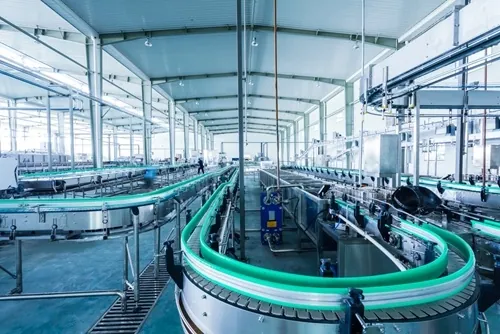
8 Warehouse Optimization Tips from Manufacturing Experts
In the age of same-day delivery and rising consumer expectations, there is immense pressure on warehouses to perform at peak efficiency. But between rising costs, complex logistics, and the constant struggle to optimize space and labor, staying ahead can feel like an uphill battle. That’s where warehouse optimization comes in.
Warehouse optimization isn’t just a buzzword; it’s a lifeline for businesses seeking to thrive in the demanding world of modern commerce. It’s a holistic approach that blends strategic planning, streamlined processes, and the right technology to transform your warehouse into a well-oiled, profit-generating machine. By maximizing space utilization, improving inventory control, and boosting workflow efficiency, you can unlock significant cost savings and elevate your customer service game.
In this comprehensive guide, we’ll explore the key elements of warehouse optimization and provide actionable strategies you can implement today. Here’s what you can expect:
- A clear definition of warehouse optimization and its core components.
- An in-depth look at the tangible benefits, from cost reduction to increased customer satisfaction.
- Eight proven optimization strategies, combining technology, best practices, and sustainable solutions.
- Essential technology solutions, including Warehouse Management Systems (WMS), Inventory Management Systems (IMS), and the transformative power of IoT and automation.
- Best practices for sustainable optimization, ensuring long-term efficiency and minimizing your environmental footprint.
- A glimpse into the future of warehouse optimization, exploring emerging trends like AI, advanced robotics, and the growing role of sustainability.
By the end of this post, you’ll have a practical roadmap to optimize your warehouse operations, boost your bottom line, and exceed customer expectations. Ready to get started? Let’s dive in.
Understanding Warehouse Optimization Fundamentals
What is Warehouse Optimization?
Warehouse optimization is a systematic approach to improving how a warehouse operates. It uses strategic planning, efficient design, and smart technology to make everything work better.. This process combines several key elements:
- Layout Planning: Organize your warehouse space strategically to maximize efficient flow.
- Process Improvement: Streamlining workflows to eliminate redundancies and bottlenecks.
- Technology Integration: Implementing automated systems and software solutions, such as automated storage and retrieval systems, includes finding the right software that works for you and avoids the common pitfalls of bad integrations.
- Resource Management: Efficiently allocating labor, equipment, and storage space.
- Data-Driven Decision Making: Using analytics to continuously refine operations. This data should come from a system that can track multiple, moving parts and integrate with existing technologies.
Key Benefits and Business Impact
Warehouse optimization offers significant advantages across multiple areas:
- Cost Reduction: Expect a decrease in operational expenses, lower labor costs, and reduced energy consumption. This cost reduction can significantly impact the bottom line, freeing up resources for other critical business initiatives.
- Operational Efficiency: See an improvement in order processing speed, enhanced inventory accuracy, and smoother picking and packing processes. Improved operational efficiency means you’ll see increased throughput, reduced lead times, and greater agility in responding to market demands.
- Space Utilization: Increase available storage capacity, better organize high-demand items, and optimize vertical space. Effective space utilization translates directly to increased storage capacity and reduced warehouse footprint and operational costs.
- Customer Satisfaction: Faster order fulfillment, fewer shipping errors, and improved order accuracy lead to happier customers. Plus, reduced walking distances and less manual handling make for a happier team. Ultimately, a well-optimized warehouse improves customer satisfaction by ensuring on-time, accurate deliveries and responsive service.
8 Warehouse Optimization Tips
Transform your warehouse with these proven strategies to optimize warehouse operations. They blend technology, smart processes, and sustainable approaches for lasting results. Think of these tips as fine-tuning the instruments in your warehouse orchestra.
1. Choose the Right Tech (WMS vs. IMS)
A Warehouse Management System (WMS) can significantly boost operational accuracy. Modern WMS platforms provide real-time tracking, order management, and better inventory visibility, all while minimizing manual errors. When choosing a system, consider whether a cloud-based or on-premise solution best suits your scalability needs, security requirements, and budget.
Keep in mind that a WMS may not be enough and you might need to add an Inventory Management System (IMS), which focuses specifically on optimizing inventory levels, forecasting demand, and preventing stockouts or overstocking. If you are using a legacy system, switching to an automated data collection solution like RFgen’s IMS may be the first step. RFgen’s mobile barcoding solutions make it easier for you to gain real-time visibility and streamline processes.
2. Integrate IoT Devices
Smart devices give you a clearer picture of your operations through automated monitoring. IoT sensors track temperature, asset movement, and inventory levels in real time, giving you actionable feedback, reducing human error, and enabling predictive maintenance. Integrating IoT devices enables businesses to fine-tune warehouse processes, prevent disruptions, and boost overall efficiency. This includes real-time visibility and tracking via mobile devices.
3. Leverage Data Analytics for Demand Forecasting
Advanced analytics tools can predict customer demand and help you optimize inventory. Data-driven forecasting improves purchasing and cuts storage expenses. Data analytics provide the intelligence to make informed decisions, optimize inventory levels, and anticipate future demand. Predictive analytics can anticipate demand fluctuations, seasonality, and market trends to optimize inventory levels and prevent costly stockouts or overstocking.
4. Embrace Lean Inventory Practices and Warehouse Layout Optimization
Adopting lean inventory principles and and optimizing warehouse operations reduces carrying costs, minimizes waste from obsolescence or spoilage, and frees up valuable warehouse space. Just-in-time inventory strategies reduce carrying costs and improve cash flow. Focus on maintaining the right stock levels based on demand and lead times to maximize your storage space.
5. Implement Regular Audit Systems
Regular audits ensure accuracy and compliance. Establish systematic checks for inventory counts, order accuracy, and quality control. Periodic assessments can help identify inefficiencies, maintain high accuracy rates, and allow you to quickly correct any issues. Regular audits help identify discrepancies, maintain data integrity, and ensure compliance with industry regulations and quality standards.
6. Invest in Staff Training
A well-trained team is key to efficiency and accuracy. Provide comprehensive training on new technologies, safety procedures, and best practices to ensure proper equipment handling, reduce accidents, and boost overall productivity. Effective training programs cover topics such as WMS, inventory control procedures, equipment operation, safety regulations, and best practices for efficient workflow.
7. Consider Third-Party Logistics (3PL)
3PL providers bring specialized expertise, advanced technologies, and economies of scale to streamline logistics operations, reduce costs, and free up internal resources. Outsourcing to a 3PL can provide access to advanced warehousing technologies, optimized logistics networks, and specialized expertise in areas such as inventory management, transportation, and order fulfillment.
8. Go Green
Embracing green practices demonstrates a commitment to environmental responsibility and can also lead to significant cost savings through reduced energy consumption and waste disposal. Install energy-efficient lighting, start recycling programs, and switch to eco-friendly packaging. Implementing sustainable warehouse operations, like a lights-out warehouse scenario, not only benefits the environment but also enhances brand image and attracts environmentally conscious customers.
Essential Technology for Modern Warehouses
Modern warehouses rely on advanced technology to streamline operations, improve productivity, and stay competitive. These technologies are the instruments that make your warehouse symphony play beautifully.
Warehouse Management Systems
A WMS is the control center for modern warehouse operations. It automates key processes and centralizes data management for receiving, shipping, storage, picking, and packing. A WMS provides real-time visibility into warehouse activity and can cut manual errors and boost order accuracy. Automating data collection with mobile devices in your warehouse is a key component of what a WMS can do for business.
Key features:
- Real-time inventory tracking
- Automated order routing
- Labor management tools
- Performance analytics
- Integration with other systems including mobile barcoding and RFID.
Inventory Management Systems
IMS give you precise control over stock levels, ensuring an optimal balance and reducing carrying costs. An IMS goes hand-in-hand with a WMS, providing the tools to manage stock levels effectively, forecast demand, and prevent both stockouts and overstocking.
Core capabilities:
- Demand forecasting
- Stock level monitoring
- Automated reordering
- Inventory turnover tracking
- Safety stock management
Internet of Things (IoT) Integration
IoT sensors and connected devices create a smart warehouse, enabling real-time monitoring and data collection. This network of sensors offers unparalleled visibility into operations and facilitates proactive maintenance. Think of it as giving your warehouse a nervous system. IoT sensors monitor various parameters like temperature, humidity, and equipment status, providing valuable data for analysis and predictive maintenance.
Applications:
- Environmental monitoring
- Asset tracking including warehouse equipment and inventory.
- Equipment maintenance alerts
- Safety compliance
- Energy optimization
Automation and Robotics
Autonomous mobile robots (AMRs) and automated guided vehicles (AGVs) are transforming warehouses by handling repetitive tasks more efficiently. As key components of warehouse automation, they reduce labor costs while improving accuracy and throughput. These robotic helpers play a vital role in boosting efficiency, especially for tasks like picking, packing, and transporting goods within the warehouse. Warehouse automation streamlines operations, reduces errors, and enables advanced technologies like robotics and AI to meet rising e-commerce demands.
Examples:
- Automated order picking with autonomous mobile robots.
- Sorting systems
- Automated transportation with automated guided vehicles.
- Robotic packaging
- Inventory scanning drones for real-time inventory updates.
Best Practices for Sustainable Optimization
Sustainable optimization means long-term efficiency with minimal environmental impact. It’s about doing well by doing good.
Safety and Compliance
- Establish clear traffic flow with designated lanes, floor markings, and signage to prevent accidents.
- Install safety barriers around high-risk areas and equipment. This creates a safer work environment for all warehouse personnel.
- Implement regular safety training and certification for equipment operators. Make sure training covers the operation of new technologies like mobile barcoding, RFID and voice solutions.
- Conduct monthly safety audits to identify and proactively address hazards.
- Establish emergency response protocols, including evacuation procedures.
Green Practices
- Install energy-efficient LED lighting with motion sensors. This reduces energy consumption and contributes to cost savings.
- Consider solar panels and other renewable energy sources. Adopting renewable energy sources reduces reliance on fossil fuels and contributes to a smaller carbon footprint.
- Implement waste reduction programs (recycling, composting). Minimizing waste through recycling and composting not only benefits the environment but also reduces waste disposal costs.
- Use biodegradable packaging and minimize waste. Switching to sustainable packaging materials further reduces environmental impact and may attract environmentally conscious customers.
- Optimize delivery routes with software to reduce fuel use. Route optimization software minimizes transportation distances and fuel consumption, contributing to cost savings and reduced emissions.
- Install energy-efficient HVAC systems and insulation. Installing energy-efficient HVAC systems and proper insulation minimizes energy waste and reduces operational costs.
- To maintain operational excellence, establish feedback loops between staff and management.
- Monitor key performance indicators (KPIs) to spot areas for improvement.
- Conduct regular operational audits, create cross-functional teams for process improvement, and implement data collection systems to track performance.
- Regularly review your technology and develop action plans based on data and feedback.
Mobile barcoding helps supply chain companies achieve their green and sustainability initiatives. Many modern companies still use paper processes and spreadsheets to record inventory movements before manually transcribing these transactions into their ERP. RFgen’s mobility solutions automate this process to reduce paper waste and increase overall efficiency. This also reduces on-hand stock levels, in turn reducing the energy consumption associated with excess storage.
The Future of Warehouse Optimization
Emerging technologies are changing warehouse operations, focusing on efficiency, sustainability, and smart automation. These advancements promise to further revolutionize warehouse operations in the years to come.
AI and Predictive Analytics
AI and machine learning improve predictive capabilities and data-driven decisions. They analyze operational data to optimize inventory, forecast demand, and improve fulfillment accuracy. Advanced analytics enable intelligent inventory management (automatically adjusting stock levels), smart route optimization (reducing picking times), predictive maintenance, and automated decision-making for resource allocation. AI and predictive analytics represent the cutting edge of warehouse optimization.
Advanced Automation
Modern warehouses are embracing sophisticated automation:
- Digital twin technology for virtual warehouse modeling and layout optimization provides a virtual replica of your warehouse to simulate different scenarios and optimize layout design before making physical changes, reducing risks and improving planning accuracy.
- AMRs for independent navigation can move freely throughout the warehouse, picking and transporting goods autonomously, boosting efficiency and reducing labor costs.
- ASRS optimize vertical space utilization and minimize wasted space.
- IoT sensors for real-time visibility into inventory and equipment provide real-time insights into equipment status, enabling predictive maintenance and minimizing downtime.
Sustainable Technologies
Environmental awareness is driving adoption of green technologies:
- Energy-efficient automation reduces energy consumption and lowers operating costs.
- Smart lighting minimizes energy waste by adjusting lighting levels based on real-time needs.
- Sustainable packaging reduces environmental impact and may appeal to eco-conscious consumers.
- Renewable energy (solar panels, energy storage) helps reduce reliance on fossil fuels and minimizes carbon footprint.
- IoT-enabled environmental monitoring for climate control optimizes energy usage by adjusting HVAC systems based on real-time environmental conditions.
These practices reduce environmental impact and offer cost savings through lower energy use and better resource management. Implementing sustainable solutions not only aligns with corporate social responsibility goals but also contributes to long-term cost savings and a positive brand image.
Conclusion
As consumer expectations continue to rise and competition intensifies, businesses must find ways to streamline their operations, maximize resources, and deliver exceptional customer service. Warehouse optimization offers a practical roadmap to achieve these goals, transforming your warehouse from a potential bottleneck into a powerful engine for growth.
By understanding the capabilities of warehouse optimization technology and how they can be integrated into your operations, you can gain a competitive edge, optimize resource allocation, and drive sustainable growth.
By implementing technology like WMS and IMS, you can transform your warehouse into a highly efficient, cost-effective, and customer-centric operation. Remember, successful warehouse optimization is an ongoing process, requiring commitment, continuous improvement, and a willingness to adapt to change. Embrace these principles and you’ll be well-equipped to meet the challenges of today’s market and build a thriving business for the future.
Frequently Asked Questions
What is warehouse optimization?
Warehouse optimization is a systematic approach to improve efficiency. It integrates layout planning, technology, and process improvements to combine strategic space utilization, inventory management, and streamlined workflows for lower costs and higher productivity. The aim is to maximize storage while minimizing expenses and improving fulfillment speed.
What are the key benefits?
Optimized warehouses typically see a cost reduction, faster order processing, and increased storage capacity. Benefits also include higher customer satisfaction (faster fulfillment, better accuracy), and improved inventory management.
How does a WMS improve operations?
A WMS automates key processes, centralizes data, and improves order accuracy. It provides real-time inventory tracking, optimizes picking routes, and improves resource allocation. Data analytics from the system support better decision-making.
What role does IoT play?
IoT devices create a smart warehouse, enabling real-time monitoring of assets, inventory, and equipment. They collect data on temperature, humidity, equipment status, and movement, helping prevent downtime, optimize storage, and improve overall efficiency.
How can warehouses be more sustainable?
Warehouses can go green by installing energy-efficient LED lighting, using solar panels, implementing waste reduction programs, and optimizing delivery routes. These initiatives are good for the environment and can generate significant cost savings.
What emerging technologies are impacting warehouse optimization?
Key emerging technologies include AI for demand forecasting, digital twins for virtual modeling, AMRs for material handling, and ASRS. These technologies boost automation, accuracy, and operational efficiency.
How can optimization improve warehouse safety?
Safety improves through clear traffic management, proper safety barriers, and regular safety audits. An optimized layout reduces accident risks by ensuring proper spacing, clear signage, and designated activity zones.
Which warehouse performance metrics should be tracked?
Track order accuracy, inventory turnover, picking efficiency, space utilization, labor productivity, and shipping accuracy. Monitoring these KPIs helps identify areas for improvement and maintain effectiveness.







